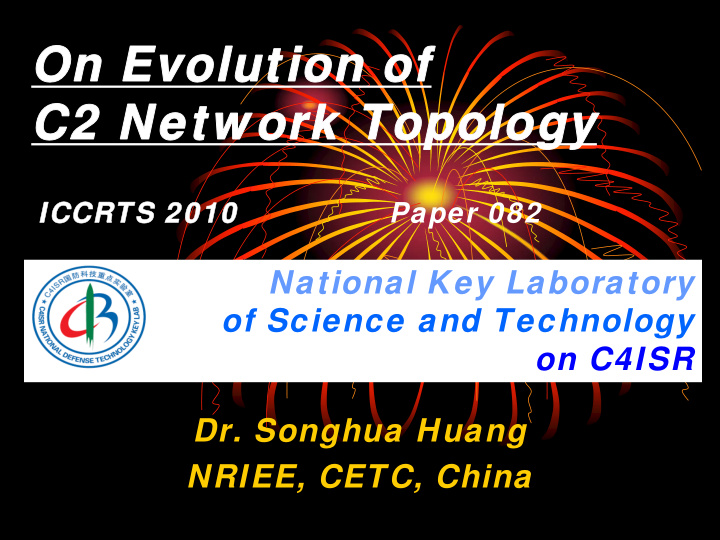



On Evolution of On Evolution of C2 Netw ork Topology C2 Netw ork Topology IC ICCR CRTS 2010 TS 2010 Paper 082 National Key Laboratory of Science and Technology on C4ISR Dr. Songhua Huang NRIEE, CETC, China
Introduction • C2 netw orks • Offer geographical decentralization, concealment, adjacency and rapid reorganization of C2 elements • Restricts complexity and uncertainty • Increases the probability of correct decision-making
Introduction • C2 netw orks • Hard to control its ow n structure • Hard to be adaptive in the respects of self-heal, self- organization , self-evolution • Typical topology models are far aw ay from the demands
C2 Netw ork Requirements • Adaptivity • dynamic evolution • Reliability • fault tolerance and self healing • Credibility • flexible, trusted netw ork • High-efficiency • quality of service, availability under attack
Topology Metrics • Link to node ratio ≈ 2 • A skew degree distribution • Small mean path length • Clustering coefficient ≈ 0.1-0.25 • A skew betw eenness distribution
Regular Netw orks • Chain Coupled Netw orks • Cheapest and simplest netw orks • Brittle w ith little redundancy • Unbearable mean path length • Degree is close to tw o • Clustering coefficient → 0
Regular Netw orks • Star Coupled Netw orks • Cheapest and simplest netw orks • Mean path length is short • S ingle point failure • Other flaw s are similar to chain topology
Regular Netw orks • Nearest-Neighbor Coupled Netw orks • Mean path length is overlong • Uniform degree distribution • Clustering coefficient drops w ith accretion of netw ork size
Regular Netw orks • Globally Coupled Netw orks • Most expensive w ith highest link to node ratio • Enormous number of decisions • Shortest mean path length • Top clustering coefficient • Not scale w ell
Random Netw orks • “ Bell ” curve degree distribution • Relatively low mean path length and clustering coefficient w ith a large variation from node to node • Vulnerable to attacks • Little controllability
Small World Netw orks • Adjustable clustering coefficient • Most efficient class of netw ork • Degrees of all nodes are mostly close
Scale-Free Netw orks • High clustering coefficient • Small w orld effect w ith mean path length rising in direct ratio to lg(n)/lg(lg(n)) • A pow er law distribution • Robust yet fragile
Situation Situation • Existing models are not practical to C2 netw orks • Fundamental problems • No pointed theory on topology creation • No method to support dynamic reconstruction of a desired topology • No mechanism for credible topology • lack of model for performance guarantee
Way out Way out • Carry out the follow ing w ork • C2 topology Characterization • C2 topology rule exploration • C2 topology modeling, resolution and construction • Natural evolutionary mechanisms of C2 topology
Conclusions Conclusions • Complex netw orks turn on a new light for topology study • Existing topology theories fail to deal w ith topology modeling, control, quantitative analysis and optimization of C2 netw ork • Precise description, construction and evolution of topology is eager for opening out
Recommend
More recommend